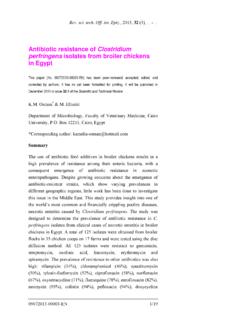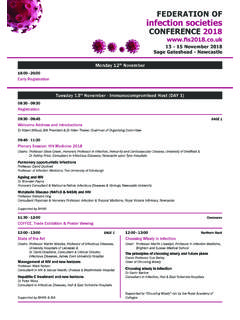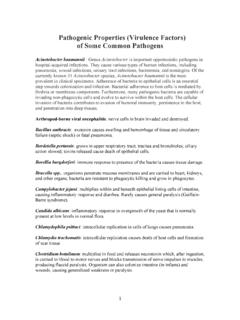Transcription of DBL™ MEROPENEM FOR INJECTION NAME OF …
1 New Zealand Data Sheet DBL MEROPENEM FOR INJECTION NAME OF MEDICINE MEROPENEM Trihydrate The chemical name of MEROPENEM trihydrate is -Azabicyclo[ ]hept-2-ene-2- carboxylic acid, 3-[[5-[(dimethylamino)carbonyl]-3-pyrrol idinyl]thio]-6-(1-hydroxyethyl)-4-methyl -7-oxo, trihydrate, [4R-[3(3S*,5S*),4 , 5 ,6 (R*)]]-.(4R,5S,6S)-3-[[(3S,5S)-5-(Dimeth ylcarbamoyl)-3-pyrrolidinyl]thio] -6-[(1R)-1-hydroxyethyl]-4-methyl-7-oxo- 1- azabicyclo[ ]hept-2-ene-carboxylic acid, trihydrate. The molecular formula of MEROPENEM trihydrate is C17H25N3O5S 3H2O and its CAS number is 119478-56-7. The structural formula of MEROPENEM trihydrate is shown below:- DESCRIPTION DBL MEROPENEM for INJECTION is presented as a sterile white powder containing MEROPENEM trihydrate equivalent to MEROPENEM , 500 mg or 1 g, blended with sodium carbonate anhydrous.
2 DBL MEROPENEM for INJECTION contains 208 mg sodium carbonate anhydrous for each gram of MEROPENEM (anhydrous potency). It contains no antimicrobial preservative and is for use in one patient on one occasion only. 20mL 30mL DBL MEROPENEM for INJECTION powder for intravenous INJECTION or infusion 500 mg 1 g Active ingredient MEROPENEM trihydrate 570 mg g Equivalent to anhydrous MEROPENEM 500 mg 1 g Excipient Sodium carbonate anhydrous 104 mg 208 mg PHARMACOLOGY MEROPENEM is a carbapenem antibiotic for parenteral use, that is stable to human dehydropeptidase-1 (DHP-1). Hosp 3 -1- New Zealand Data Sheet Microbiology MEROPENEM exerts its bactericidal action by interfering with vital bacterial cell wall synthesis.
3 The ease with which it penetrates bacterial cell walls, its high level of stability to all serine -lactamases and its marked affinity for the Penicillin Binding Proteins (PBPS) explain the potent bactericidal action of MEROPENEM against a broad spectrum of aerobic and anaerobic bacteria. Bactericidal concentrations are commonly the same as the minimum inhibitory concentrations (MICs). MEROPENEM is stable in susceptibility tests and these tests can be performed using normal routine methods. In vitro tests show that MEROPENEM acts synergistically with various antibiotics. It has been demonstrated both in vitro and in vivo that MEROPENEM has a post-antibiotic effect.
4 MEROPENEM is usually active, in vitro and in clinical infections, against the following strains of bacteria shown below: Gram-positive aerobes: Enterococcus faecalis, Staphylococcus aureus (penicillinase negative and positive), Staphylococci-coagulase-negative including Staphylococcus epidermidis, streptococci including Streptococcus pneumoniae, Streptococcus agalactiae, Streptococcus pyogenes, Streptococcus mitis, Streptococcus milleri, Streptococcus sanguis, Streptococcus viridans. Gram-negative aerobes: Acinetobacter anitratus, Citrobacter spp., including Citrobacter freundii, Enterobacter aerogenes, Enterobacter cloacae, and other Enterobacter spp.
5 , Escherichia coli, Haemophilus influenzae (including -lactamase positive strains), Moraxella (Branhamella) catarrhalis, Neisseria gonorrhoeae, Neisseria meningitidis, Klebsiella pneumoniae, and other Klebsiella spp., Morganella morganii, Proteus mirabilis, Serratia spp. Anaerobic bacteria: Bacteroides fragilis, Bacteroides thetaiotaomicron, and other Bacteroides spp., Clostridium spp. including C. perfringens, Eubacterium lentum, Fusobacterium spp., Mobiluncus curtisii, Peptostreptococcus spp., Peptococcus spp. Some strains of Pseudomonas aeruginosa are susceptible to MEROPENEM in vitro and in clinical infections.
6 Enterococcus faecium, Stenotrophomonas (Xanthomonas) maltophilia, and methicillin resistant staphylococci have been found to be resistant to MEROPENEM . Disc Suseptibility Dilution or diffusion techniques-either quantitative (MIC) or breakpoint, should be used following a regularly updated, recognised and standardised method, (eg NCCLS). Standard susceptibility test procedures require the use of laboratory control microorganisms to control the technical aspects of the laboratory procedures. A report of Susceptible indicates that the pathogen is likely to be inhibited if the antimicrobial compound in the blood reaches the concentrations usually achievable.
7 A report of Intermediate indicates that the result should be considered equivocal, and if the microorganism is not fully susceptible to alternative, clinically feasible drugs, the test should be repeated. This category implies possible clinical applicability in body sites Hosp 3 -2- New Zealand Data Sheet where the drug is physiologically concentrated or in situations where high dosage of drug can be used. This category also provides a buffer zone, which prevents small- uncontrolled technical factors from causing major discrepancies in interpretation. A report of Resistant indicates that the pathogen is not likely to be inhibited if the antimicrobial compound in the blood reaches the concentration usually achievable, other therapy should be selected.
8 Note: The prevalence of resistance may vary geographically for selected species and local information on resistance is desirable, particularly when treating severe infections. Pharmacokinetics A 30 minute intravenous infusion of a single dose of MEROPENEM in normal volunteers results in peak plasma levels of approximately 11 microgram/mL for the 250 milligram dose, 23 microgram/mL for the 500 milligram dose, 49 microgram/mL for the 1 g dose and 115 microgram/mL following the 2 g dose. A 5 minute intravenous bolus INJECTION of MEROPENEM in normal volunteers results in peak plasma levels of approximately 52 microgram/mL for the 500 mg dose and 112 microgram/mL for the 1g dose.
9 Intravenous infusions over two minutes, three minutes and five minutes of a 1g dose of MEROPENEM were compared in a three-way crossover trial. These durations of infusion resulted in peak plasma levels of 110, 91 and 94 microgram/mL, respectively. After an intravenous dose of 500 mg, plasma levels of MEROPENEM decline to values of 1 microgram/mL or less than six hours after administration. When multiple doses are administered at eight hourly intervals to subjects with normal renal function, accumulation of MEROPENEM does not occur. In subjects with normal renal function, MEROPENEM 's elimination half-life is approximately one hour.
10 Plasma protein binding of MEROPENEM is approximately 2%. Approximately 70% of the intravenous administered dose is recovered as unchanged MEROPENEM in the urine over 12 hours, after which little further urinary excretion is detectable. Urinary concentrations of MEROPENEM in excess of 10 microgram/mL are maintained for up to five hours at the 500 mg dose. No accumulation of MEROPENEM in plasma or urine was observed with regimens using 500 mg administered every eight hours or 1g administered every six hours in volunteers with normal renal function. The only metabolite of MEROPENEM is microbiologically inactive.












